
The Gaulish warrior Asterix has been a French institution since he first appeared in 1961’s Asterix the Gaul. He’s accompanied by his inseparable friend Obelix and aided by the druid Getafix’s magic potion that gives superhuman strength. His cunning defends his Gaulish village from Romans, Vikings, and even aliens.
Four different teams have produced Asterix stories:
- 24 books from Asterix the Gaul (1961) to Asterix in Belgium (1979) written by Rene Goscinny and illustrated by Albert Uderzo
- 8 books from Asterix and the Great Divide (1980) to Asterix and the Falling Sky (2005) written and illustrated by Albert Uderzo
- 5 books from Asterix and the Picts (2013) to Asterix and the Griffin (2021) written by Jean-Yves Ferri and illustrated by Didier Conrad
- 1 book from 2023 written by Fabcaro and illustrated by Didier Conrad.
Most Asterix fans will agree that the Goscinny era is the franchise’s strongest. Uderzo’s first books after Goscinny’s sudden passing are enjoyable, but his later efforts are problematic. The recent efforts from Jean-Yves Ferri and Didier Conrad are worthy – a rebound from Uderzo’s later albums, but not as strong as Goscinny’s best.
I didn’t include Asterix and Obelix’s Birthday: The Golden Book and Asterix and the Class Act, both collections of short stories, in this countdown of best Asterix books.
Asterix Comics Ranked
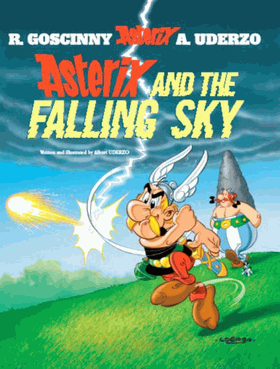
#38 Asterix and the Falling Sky
2005
Uderzo’s final Asterix book is a franchise low-point. Bizarrely, it’s a satire of the French comic industry and a tribute to Walt Disney. Neither of these themes explains a story about two warring factions of aliens – it ventures too far from usual Asterix territory to feel like part of the series. As with other lesser Uderzo efforts, the plotline relies on Getafix’s various potions for momentum.
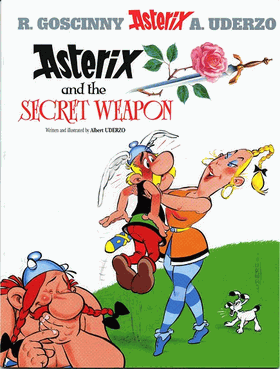
#37 Asterix and the Secret Weapon
1991
Asterix and the Secret Weapon is shockingly sexist. No one needed an Asterix book addressing feminism and gender issues. The book’s climactic scene, Asterix’s solution to a cohort of female legionaries invading the village, is especially cringe-inducing.

#36 Asterix and Obelix All at Sea
1996
Asterix and Obelix All at Sea is a fast-paced adventure that’s Asterix at its least coherent. There’s little explanation for Obelix’s various states of metamorphosis, and it seems likely that Uderzo was making it up as he went along. It’ll probably work for kids, but requires too much suspension of disbelief for adult readers to truly enjoy.
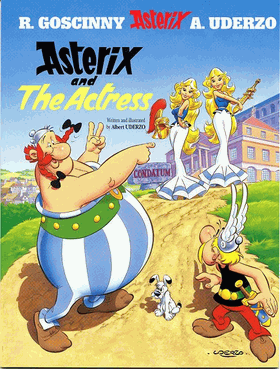
#35 Asterix and the Actress
2001
Asterix and the Actress features the Roman’s flimsiest scheme, hiring an actress to impersonate Panacea. It also features an alarming amount of fan service. The story introduces Asterix and Obelix’s parents. It also brings Tragicomix, Panacea, and Tremensdelirius from earlier adventures. The scene where Asterix is rescued by a dolphin stretches credibility.
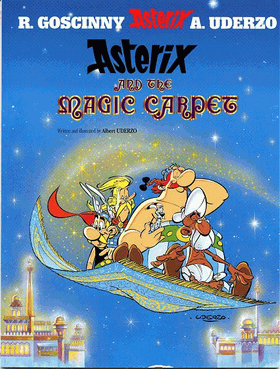
#34 Asterix and the Magic Carpet
1987
In which Asterix, Obelix, and Cacofonix travel to India on a magic carpet. It was fast-moving enough to entertain me as a kid. In hindsight, it marks the start of an era where Uderzo was out of new ideas for stories and relies on novelty to drive the series.
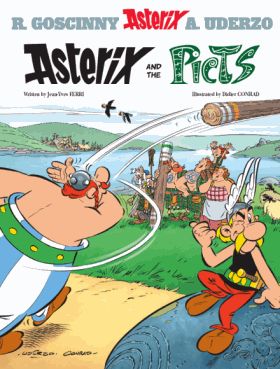
#33 Asterix and the Picts
2013
In Ferri and Conrad’s first Asterix adventure, Asterix, Obelix, and Dogmatix visit Caledonia (Scotland). It’s a good old-fashioned Asterix romp, a crowdpleaser that plays it safe. The characters’ names are just as amusing as ever, with Camomilla and Macaroon the central couple.
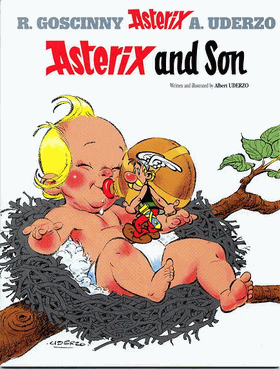
#32 Asterix and Son
1983
When an unnamed baby is left outside Asterix’s hut, rumours fly about its parentage and Asterix sets off on a quest to return it to its parents. It’s one of the most eventful books in the series – the baby drinks the magic potion! the Gaulish village burns down! – and it’s also the last worthwhile Uderzo effort.

#31 Asterix and the Chariot Race
2017
Chariot Race is another solid Ferri and Conrad effort that recaptures the elegant simplicity of classic Asterix adventures. Naming a rival chariot driver “Coronavirus” was scarily prescient. It’s also noteworthy as the first Asterix book not translated into English by Anthea Bell.
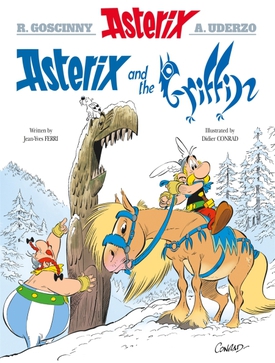
#30 Asterix and the Griffin
2021
Asterix, Obelix, and Getafix travel to the eastern reaches of the known world, Sarmatia. The book breaks the formula by starting the Gauls’ story when they’re already close to their destination, allowing for more interesting storytelling. The most viable love interest yet for the main characters is handled surprisingly well.

#29 Asterix and the Black Gold
1981
Asterix’s visit to the Middle East is an early Uderzo-written effort that maintains the goodwill from the Goscinny years. The odd blend of James Bond gadgets and Biblical allusions is memorable. The oil jokes are funny, as are the scenes where the Gauls are attacked by a series of wandering warriors in the desert. The revelation that the entire adventure was a wild goose chase is surprisingly effective.

#28 Asterix and the Chieftain’s Daughter
2019
Centering Ferri and Conrad’s fourth adventure on a strong, yet unpredictable, female character is a good move. As a music blogger, I appreciate the updated popular cultural references, shifting from a disdain of popular music in the Goscinny adventures to quoting Culture Club’s ‘Karma Chameleon’
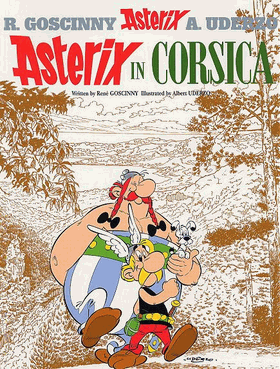
#27 Asterix in Corsica
1973
My least favourite of Goscinny’s Asterix books, Corsica is insular with its clan feuds, siestas, and maquis. It was popular in France but not in its English edition. This is probably because it requires some background knowledge about the French island of Corsica to make any sense.
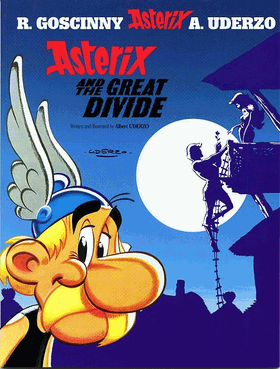
#26 Asterix and the Great Divide
1980
Uderzo’s first story as both writer and artist is his best. As the cover indicates he borrows liberally from Romeo and Juliet, but it’s a better strategy than piling on gratuitous travel and potions. Codfix, who bears a resemblance to Grima Wormtongue from The Lord of the Rings, is one of the franchise’s most memorable villains.

#25 Asterix and the Golden Sickle
1962
The second volume in the Asterix series doesn’t make a lot of sense if you don’t read the books in order. The journey to Paris (aka Lutetia) is hyped as terribly dangerous, but soon Asterix and Obelix would be travelling around the known world. The corrupt Prefect of Lutetia, Surplus Dairyprodus, boasts one of the series’ best names.
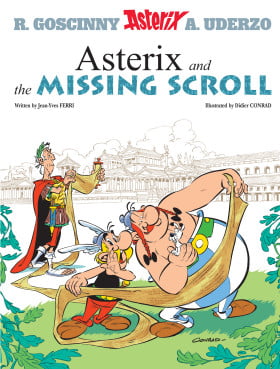
#24 Asterix and the Missing Scroll
2015
Missing Scroll was inspired by WikiLeaks’ Julian Assange. It’s amusingly meta, as Caesar tries to erase the indomitable Gaulish village from written history, only to be challenged by the Assange-like Confoundtheirpolitix.

#23 Asterix in Belgium
1979
Goscinny suddenly passed away during the creation of Asterix in Belgium – marked by the remainder of the story featuring rainy backdrops. It’s one of Goscinny’s weaker stories, however – there’s not much at stake in the contest between the Belgians and the Gauls for bravery,
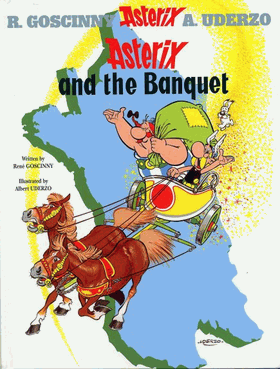
#22 Asterix and the Banquet
1965
Uderzo and Goscinny parody the Tour de France cycle race in this culinary tour around Gaul. It marks the first appearance of Dogmatix. Banquet has more plotholes than any other Goscinny-penned Asterix book:
– why don’t the Gauls use the magic potion to break through the stockade?
– why don’t the Gauls run out of food while they’re fenced in?
– how do the Nice salad and Marseille fish stew remain edible for the banquet without refrigeration?
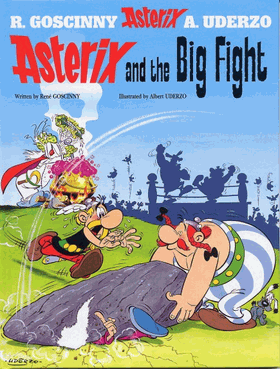
#21 Asterix and the Big Fight
1966
Vitalstatistix is challenged to an (anachronistic) boxing match by another chief. When Getafix is injured by a stray menhir, Asterix takes on the role of Vitalstatistix’s trainer. The Muhammad Ali references went over my head as a kid, but watching an unhinged Getafix making potions was fun.
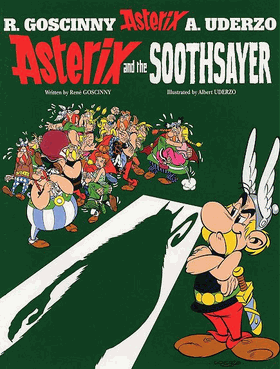
#20 Asterix and the Soothsayer
1972
Asterix and the Soothsayer is similar to Roman Agent from a couple of years earlier, where a charismatic outsider threatens the unity of the Gaulish village. It’s one of the spookiest books in the series, with the intimidating lightning and fortune-telling.

#19 Asterix the Gaul
1961
Asterix the Gaul is limited in scope compared to later volumes. All the action takes place in and around the Gaulish village. But it was deservedly an instant success. The scenes when Asterix and Getafix troll the Romans, making them scramble for obscure ingredients like strawberries and tricking them into drinking a facial hair growth accelerator, are hilarious. Unlike later stories, Getafix is Asterix’s main sidekick here.
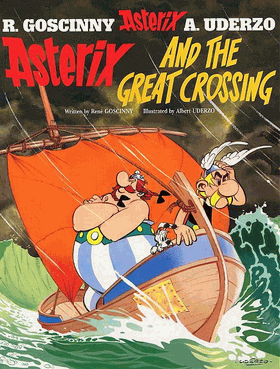
#18 Asterix and the Great Crossing
1975
Asterix and Obelix set off on a fishing expedition and inadvertently discover the Americas, full of “Gobblers” (turkeys) and “Romans” (Native Americans). Obelix’s foreshadowing of the Statue of Liberty is an iconic moment.
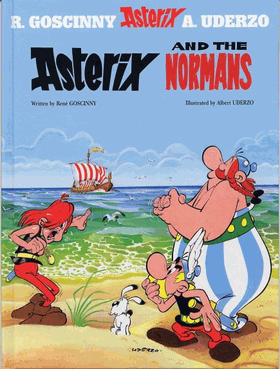
#17 Asterix and the Normans
1966
The Gaulish village is troubled by a marauding shipload of Vikings – Asterix and the Vikings would have been a better title. It’s creepy for a children’s book, with the mugs made from the skulls of the conquerors’ enemies. The ending, where the Vikings’ quest was only too successful, is satisfying.
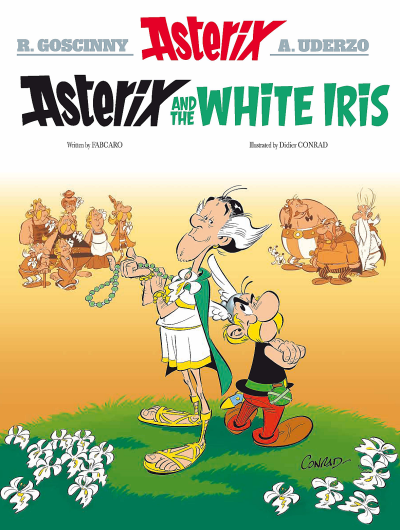
#16 Asterix and the White Iris
New Asterix writer Fabcaro is off to a great start with The White Iris. It’s the funniest Asterix book in decades. It follows a familiar template – a Roman infiltrating the village. Positivity coach Isivertuus is the most oddball of the Roman infiltrators. It’s well executed, full of fun gags. Vitalstatistix’s wife Panacea takes a welcome turn in the spotlight.

#15 Asterix and the Goths
1963
Goscinny and Uderzo later expressed regret about the anti-German tone of this book. It’s an amusing summation of how Germany functioned as separate states before Otto von Bismarck’s unification in 1871; the diagram that explains the Asterixian Wars is amazing. The naïve border guard’s lack of understanding of what constitutes an invasion is a great gag.
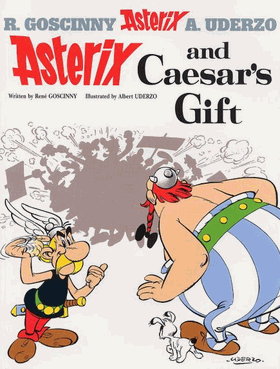
#14 Asterix and Caesar’s Gift
1974
Julius Caesar causes chaos in the Gaulish village when he gifts it to a drunken officer as a prank. The political campaigning is fun, especially Geriatrix’s futile attempt at forming his own political party.

#13 Asterix and the Roman Agent
1970
Julius Caesar dispatches a contentious individual named Tortuous Convolvulus to spread discord in the Gaulish village. Convolvulus is a fascinating adversary, smoothly creating enmity wherever he goes (represented by green speech bubbles). Vitalstatistix’s wife Impedimenta is great here, pointing out that if the village is chronicled, “they won’t be calling it the Adventures of Vitalstatistix the Gaul”.

#12 Asterix and the Cauldron
1969
Asterix and Obelix resort to odd jobs to repay a debt, with hilarious results. The scenes where they try to sell wild boar and Obelix’s stint at acting are particularly memorable. The taxman whose speech is in the form of official documents is an excellent minor character, and it’s lovely to finally see some good fortune for the pirates.
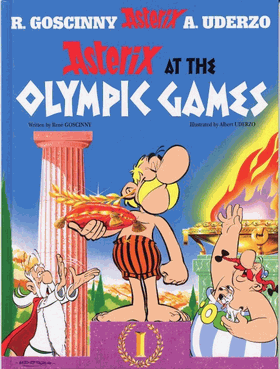
#11 Asterix at the Olympic Games
1968
It’s time for a boy’s trip, as the men of the Gaulish village travel to Olympia. The story was originally serialised to coincide with the Mexico Olympics in 1968. It’s effectively Asterix in Greece – as well as exploring Greek culture, it also parodies the contemporary Olympics’ struggle against performance-enhancing drugs.

#10 Asterix the Gladiator
1964
Asterix and Obelix travel to Rome to rescue Cacofonix the bard. The scenes where the Gauls teach the reluctant gladiators the yes-no-black-white parlour game are highlights. Several series mainstays make their debut here – it’s the first time Obelix utters the catchphrase “these Romans are crazy!”, while it also marks the first appearance of the pirates.
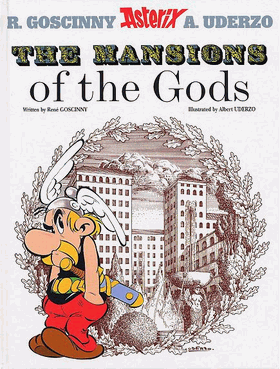
#9 The Mansions of the Gods
1971
The Romans, spearheaded by architect Squaronthehypotenus, attempt to corrupt the Gauls with civilisation. Like Obelix and Co., it tackles economics; it’s fun to see the Gauls thwart the Romans’ plans with magic acorns, then turn around and help the oppressed slaves with their magic potion.
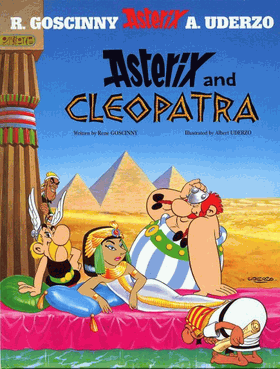
#8 Asterix and Cleopatra
1965
The Gauls travel to Egypt to build a temple, aiding the alarmingly incompetent architect Edifis. The story also explains the reason for the Sphinx’s missing nose, and the scene where the Gauls are trapped in the pyramid and Getafix finally allows Obelix some magic potion is memorable.

#7 Asterix in Spain
1969
Asterix and Obelix need to return a hostage to a lone village in Spain that still holds out against the Roman invaders. Pepe is one of the series’ most memorable characters, with his habit of holding his breath. Obelix takes up Spanish dancing (“¡Olé!”) and Asterix takes up bullfighting.

#6 Asterix and the Chieftain’s Shield
1968
Chief Vitalstatistix takes the spotlight in the 11th Asterix adventure. When he’s sent to Averne spas for a health cure, Asterix and Obelix are caught up in a search for the shield of Vercingetorix, a conquered Gaulish chieftain. It’s a fun mystery, and the recurring gag where the Roman soldiers search through coal cellars is delightful.
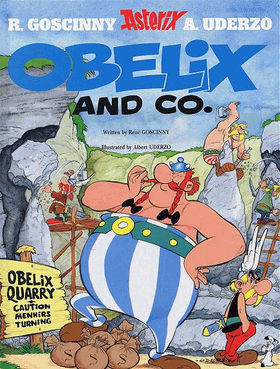
#5 Obelix and Co.
1976
The final Asterix adventure published before Goscinny’s death, Obelix and Co. is a sophisticated parody of capitalism. A young business student attempts to corrupt the Gauls through greed – it’s fun to see the effects of the menhir boom ripple through the Roman empire.

#4 Asterix in Britain
1966
Goscinny and Uderzo’s Britain is full of warm beer and tea. The reference to French language instruction (“It is smaller than the garden of my uncle, but larger than the pen of my aunt”) is subtly hilarious, and Obelix would certainly make a great rugby prop.
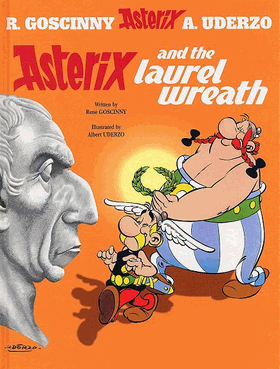
#3 Asterix and the Laurel Wreath
1971
The Gauls are the aggressors in this tale, travelling to Rome to procure Caesar’s laurel wreath. There’s a lot of alcohol involved; “ferpectly right”, “zigackly”, and a hangover cure that includes an unplucked hen, carbolic soap, black pudding, and pomegranate seeds. The ending, where Caesar unaccountably feels like a fish after his laurel wreath is replaced with parsley, is priceless.

#2 Asterix in Switzerland
1970
Several of the most interesting Asterix plots involve the Gauls temporarily teaming up with the Romans. Quaestor Vexatius Sinusitus is held hostage in the village while Asterix and Obelix seek out a potion ingredient in Switzerland. Reading as a kid, this book left me confused about what an orgy was – for a long time I assumed it involved a lot of cheese. The scenes in the bank vault and Obelix’s insistence that Switzerland is flat are both great moments.
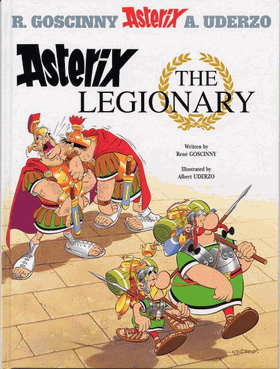
#1 Asterix the Legionary
1967
The Asterix series frequently exploits clichés about other countries. They’re in overdrive here thanks to the eclectic cast of new recruits. The Egyptian who talks in hieroglyphics is especially funny (old hairy nose!). The bureaucracy in the recruiting centre is amazing and, as with Asterix in Switzerland, the Gauls temporarily allying with the Romans creates an unpredictable plot.
Read More
22 Comments
Leave a Reply
About
Aphoristic Album Reviews is almost entirely written by one person. It features album reviews and blog posts across a growing spectrum of popular music.
Review Pages
Read about the discographies of musical acts from the 1960s to the present day. Browse this site's review archives or enjoy these random selections:
Blog Posts
I add new blog posts to this website every week. Browse the archives or enjoy these random selections:











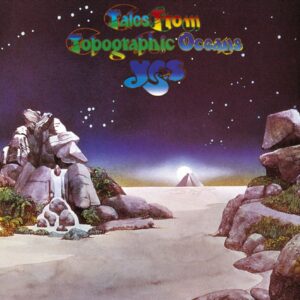








What age group are these books aimed at? I just looked up Albert Uderzo… over 370 million books sold with his artwork.
The artwork seems so familiar. I could swear in the late seventies I saw this cartoon in the paper…I’m not sure they ran here like that.
They’re good for older kids and for adults – there’s enough subtle humour that they work for grown-ups. Lots of funny names.
Ok cool. I go book shopping (when the world isn’t on fire) at different places… and I’ll pick some if I can find them…I’m pretty sure I’ve seen them out.
I’m a huge Peanuts fan. I was just looking to see if they were ever translated to a comic strip…i couldn’t find that but I did find where they reference the Peanuts in Asterix and Cleopatra.
What do you mean by translated to a comic strip?
There’s a pretty good Peanuts series on Netflix where they pretty much just present the original cartoons in low-key form.
Oh….I couldn’t think of the right word but formatted to a Sunday comic section.
I haven’t seen that but I must…I have all of the cartoons and we have many of the books. My wife and I bonded over the Peanuts in the 90s right before we got married. We traveled through states for 60s and 70s Peanut items…at flea markets. We have plastic containers full of watches, games, and about everything Peanuts…so yes…I’m a fan.
I don’t think Asterix was ever serialised into 4-panel strips. Everything I’ve seen has been long-form stories.
I think the Secret Weapon is one of the better solo Uderzo books. I don’t think its depiction of women is any more sexist than the depiction of men in the rest of the series. It’s the same thing for black and Native American characters, their depiction is no more racist than any other people who appear in these books. I find that it’s usually Americans who make these complaints they don’t seem to understand the concept of caricature.
I think it’s pretty key that Great Crossing is from 1975 and Secret Weapon is from 1991 – feels like Uderzo didn’t really change with his audience.
Good for him, he didn’t dumb down or change to cater to certain people’s ‘feelings’. Feminism, quite rightly, promotes equality between the sexes so Uderzo, acknowledging that, lampooned women in the same way men had been lampooned in the rest of the series. It’s a funny book because there’s a certain amount of truth in the caricatures. It’s certainly a big improvement on the Magic Carpet.
I saved this list because I know it will come in handy some day.
Man I remember reading Asterix as a kid, they had them in the library at our grade school. Hadn’t thought of them in years, not since a buddy in Montreal was a big fan (we left Montreal in 2001, so yeah it’s been a while).
While along with every other long term reader I would rank Falling Sky as the absolute worst, my pick for No. 1 would be Roman Agent. Nothing else comes close.
I never quite warmed to the discord in the village plots as much – they fight enough with each other anyway, without anyone helping them.
I have to mostly agree with this ranking (although I’ve only read the Goscinny ones). I would rate Olympic Games somewhat higher (maybe #7, ahead of Asterix in Spain) and Great Crossing MUCH lower (outside the top 20, at least), and maybe Chieftain’s Shield should be in the top 5 just ahead of Asterix in Britain and Obelix and co. I can’t argue with much else. Glad to see it’s not just from nostalgia that I think Asterix the Legionary is the best (it was the first one I read).
Any reason you don’t like Great Crossing? I read most of these as a young kid, so that’s probably clouding my judgement.
I read it as a kid too, but I never liked it. I think it was the departure from the classical Roman world. Asterix without Romans just never sat right with me. Also, the presence of vikings 700 years before there were any vikings. Asterix was always ahistorical, but it was at its best when it used anachronism for satire, depicting ancient peoples with the stereotypes of their modern counterparts (e.g. Asterix in Britain, Asterix in Switzerland, etc), or modern problems in the ancient world (e.g. Obelix and Co, Mansions of the Gods). But the vikings in Great Crossing aren’t scandinavian stereotypes superimposed onto classical era scandinavians, they’re just straight up vikings in the wrong period of history.
Also, it loses marks for the tiresome old fashioned racist depiction of native Americans, of the sort that makes stuff like Tintin in America or Disney’s Peter Pan problematic today.
Great piece. Thanks
Thanks for reading!
My top five are #1…Asterix At The Olympics, #2…In Spain, #3…The Big Fight, #4…In Britain, #5…Mansions Of The Gods.
As with so many things Asterix seemed to peak between the mid 1960s and early 70s – the stories were memorable and laced with clever wordplay, and all complimented by Uderzo’s magnificent drawings. The first one i didn’t really enjoy was 1975’s Asterix And The Great Crossing, and after Goscinny died they ranged from pretty bad to completely abominable, ruined by increasingly preposterous storylines, some utterly puerile dialogue and ever more sloppy artwork. Sadly, the whole Asterix franchise has become a parody of itself, like an ageing rock group that doesn’t know when to quit; i’ll just stick with the brilliance and originality of the first 20 books.
I just read Spain to my 11 year old on Monday. I never noticed too much of a decline in the Goscinny years, but after that it’s a decidedly mixed bag.
Have you tried the new ones – I don’t think they threaten the Goscinny era, but they’re enjoyable enough.
Bonjour, I can’t wait to read your feedback regarding the 40th Asterix album (L’Iris Blanc) and what its ranking will be.
It’ll be interesting – first book from a new writer, i believe. Thanks for writing in!